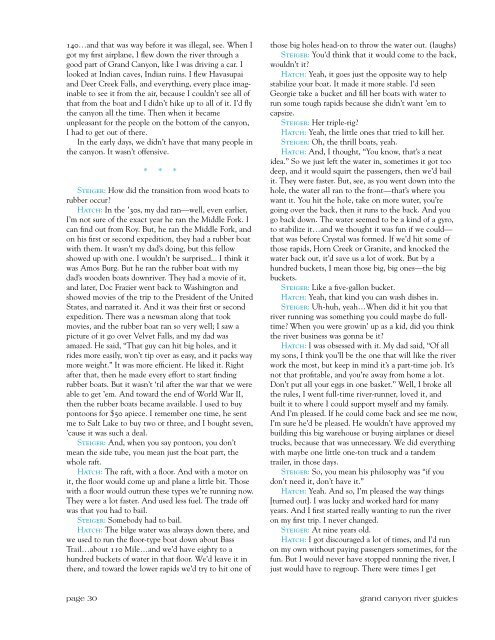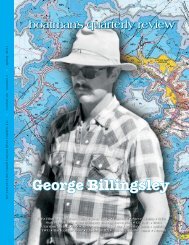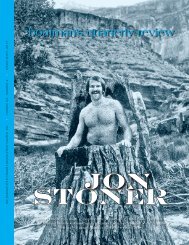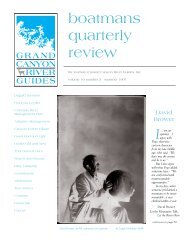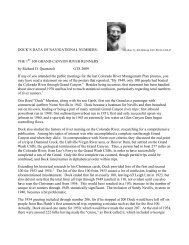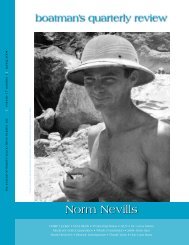summer 03 / 16:2 - Grand Canyon River Guides
summer 03 / 16:2 - Grand Canyon River Guides
summer 03 / 16:2 - Grand Canyon River Guides
- No tags were found...
You also want an ePaper? Increase the reach of your titles
YUMPU automatically turns print PDFs into web optimized ePapers that Google loves.
140…and that was way before it was illegal, see. When Igot my first airplane, I flew down the river through agood part of <strong>Grand</strong> <strong>Canyon</strong>, like I was driving a car. Ilooked at Indian caves, Indian ruins. I flew Havasupaiand Deer Creek Falls, and everything, every place imaginableto see it from the air, because I couldn’t see all ofthat from the boat and I didn’t hike up to all of it. I’d flythe canyon all the time. Then when it becameunpleasant for the people on the bottom of the canyon,I had to get out of there.In the early days, we didn’t have that many people inthe canyon. It wasn’t offensive.* * *Steiger: How did the transition from wood boats torubber occur?Hatch: In the ’30s, my dad ran—well, even earlier,I’m not sure of the exact year he ran the Middle Fork. Ican find out from Roy. But, he ran the Middle Fork, andon his first or second expedition, they had a rubber boatwith them. It wasn’t my dad’s doing, but this fellowshowed up with one. I wouldn’t be surprised... I think itwas Amos Burg. But he ran the rubber boat with mydad’s wooden boats downriver. They had a movie of it,and later, Doc Frazier went back to Washington andshowed movies of the trip to the President of the UnitedStates, and narrated it. And it was their first or secondexpedition. There was a newsman along that tookmovies, and the rubber boat ran so very well; I saw apicture of it go over Velvet Falls, and my dad wasamazed. He said, “That guy can hit big holes, and itrides more easily, won’t tip over as easy, and it packs waymore weight.” It was more efficient. He liked it. Rightafter that, then he made every effort to start findingrubber boats. But it wasn’t ‘til after the war that we wereable to get ’em. And toward the end of World War II,then the rubber boats became available. I used to buypontoons for $50 apiece. I remember one time, he sentme to Salt Lake to buy two or three, and I bought seven,’cause it was such a deal.Steiger: And, when you say pontoon, you don’tmean the side tube, you mean just the boat part, thewhole raft.Hatch: The raft, with a floor. And with a motor onit, the floor would come up and plane a little bit. Thosewith a floor would outrun these types we’re running now.They were a lot faster. And used less fuel. The trade offwas that you had to bail.Steiger: Somebody had to bail.Hatch: The bilge water was always down there, andwe used to run the floor-type boat down about BassTrail…about 110 Mile…and we’d have eighty to ahundred buckets of water in that floor. We’d leave it inthere, and toward the lower rapids we’d try to hit one ofthose big holes head-on to throw the water out. (laughs)Steiger: You’d think that it would come to the back,wouldn’t it?Hatch: Yeah, it goes just the opposite way to helpstabilize your boat. It made it more stable. I’d seenGeorgie take a bucket and fill her boats with water torun some tough rapids because she didn’t want ’em tocapsize.Steiger: Her triple-rig?Hatch: Yeah, the little ones that tried to kill her.Steiger: Oh, the thrill boats, yeah.Hatch: And, I thought, “You know, that’s a neatidea.” So we just left the water in, sometimes it got toodeep, and it would squirt the passengers, then we’d bailit. They were faster. But, see, as you went down into thehole, the water all ran to the front—that’s where youwant it. You hit the hole, take on more water, you’regoing over the back, then it runs to the back. And yougo back down. The water seemed to be a kind of a gyro,to stabilize it…and we thought it was fun if we could—that was before Crystal was formed. If we’d hit some ofthose rapids, Horn Creek or Granite, and knocked thewater back out, it’d save us a lot of work. But by ahundred buckets, I mean those big, big ones—the bigbuckets.Steiger: Like a five-gallon bucket.Hatch: Yeah, that kind you can wash dishes in.Steiger: Uh-huh, yeah…When did it hit you thatriver running was something you could maybe do fulltime?When you were growin’ up as a kid, did you thinkthe river business was gonna be it?Hatch: I was obsessed with it. My dad said, “Of allmy sons, I think you’ll be the one that will like the riverwork the most, but keep in mind it’s a part-time job. It’snot that profitable, and you’re away from home a lot.Don’t put all your eggs in one basket.” Well, I broke allthe rules, I went full-time river-runner, loved it, andbuilt it to where I could support myself and my family.And I’m pleased. If he could come back and see me now,I’m sure he’d be pleased. He wouldn’t have approved mybuilding this big warehouse or buying airplanes or dieseltrucks, because that was unnecessary. We did everythingwith maybe one little one-ton truck and a tandemtrailer, in those days.Steiger: So, you mean his philosophy was “if youdon’t need it, don’t have it.”Hatch: Yeah. And so, I’m pleased the way things[turned out]. I was lucky and worked hard for manyyears. And I first started really wanting to run the riveron my first trip. I never changed.Steiger: At nine years old.Hatch: I got discouraged a lot of times, and I’d runon my own without paying passengers sometimes, for thefun. But I would never have stopped running the river, Ijust would have to regroup. There were times I getpage 30grand canyon river guides


